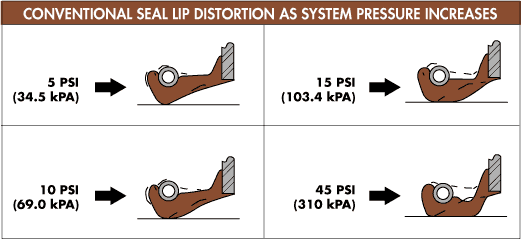|
|

  |
 |
 |
 PROPER SEAL SELECTION FOR SYSTEM PRESSURE PROPER SEAL SELECTION FOR SYSTEM PRESSURE
A standard oil seal design will handle internal pressures to 5 psi with occasional
excursions to 10 psi. The key to the design of an oil seal is the primary lipís ability
to follow shaft eccentricity while applying a light load at the lip contact point. The
suspended beam construction of the lip, which allows flexibility, is inherently poor
in resisting internal system pressure. The figure below shows the effects of
pressure on a seal lip from 5 psi to 45 psi.

An oil sealís lip contacts the shaft tracking over the same point as the shaft rotates
at high RPM. Minimizing frictional heat, which can shorten seal life, relies on a
minimum contact area and load between the seal lip and shaft. As internal pressure
increases, both the lip load and the contact area increase, reducing seal life. At
pressures approaching 45 psi the beam of the seal can be pressed against the
shaft, a condition known as bell mouthing, causing immediate leakage. Wear caused
by high pressure is evident on the barrel angle toward the air side of the seal,
often with no evidence of wear on the lip contact point.
deVries International oil seals can be designed for higher pressure by increasing
the thickness of the lipís flex section or supporting the lip with a backing-ring. These
designs are specific to each customer application and require thorough customer
testing. The TCHP design is capable of handling pressures to 50 psi. The SCH and
SCHH designs, using a reinforced nylon backup, and VTR using reinforced Teflon,
are capable of handling pressures well above 100 psi.

|
|
|
|






